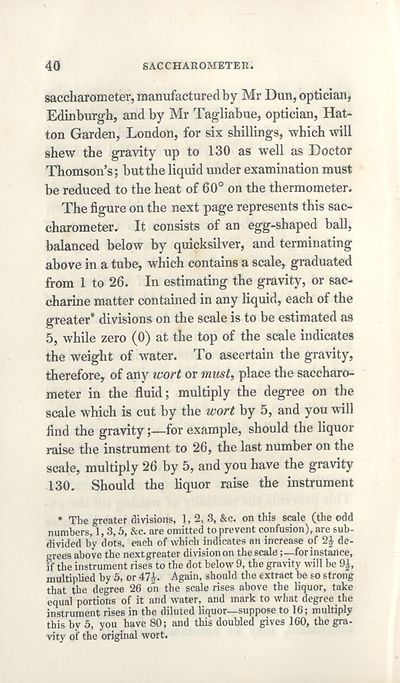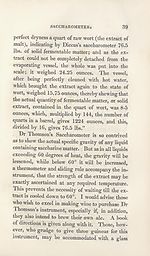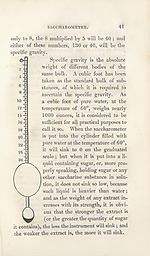Download files
Complete book:
Individual page:
Thumbnail gallery: Grid view | List view

40
8ACCHAROMETER.
saccharometer, manufactured by Mr Dun, optician,
Edinburgh, and by Mr Tagliabue, optician, Hat¬
ton Garden, London, for six shillings, which will
shew the gravity up to 130 as well as Doctor
Thomson’s; but the liquid under examination must
be reduced to the heat of 60° on the thermometer.
The figure on the next page represents this sac¬
charometer. It consists of an egg-shaped ball,
balanced below by quicksilver, and terminating
above in a tube, which contains a scale, graduated
from 1 to 26. In estimating the gravity, or sac¬
charine matter contained in any liquid, each of the
greater* divisions on the scale is to be estimated as
5, while zero (0) at the top of the scale indicates
the weight of water. To ascertain the gravity,
therefore, of any wort or must, place the saccharo¬
meter in the fluid; multiply the degree on the
scale which is cut by the wort by 5, and you will
find the gravity;—for example, should the liquor
raise the instrument to 26, the last number on the
scale, multiply 26 by 5, and you have the gravity
130. Should the liquor raise the instrument
* The greater divisions, 1, 2, 3, &c. on this scale (the odd
numbers, 1, 3,5, &c. are omitted to prevent confusion), are sub¬
divided by dots, each of which indicates an increase of 2£ de¬
grees above the nextgreater division on the scalefor instance,
if the instrument rises to the dot below 9, the gravity will be 9|,
multiplied by 5, or 47|. Again, should the extract he so strong
that the degree 26 on the scale rises above the liquor, take
equal portions of it and water, and mark to what degree the
instrument rises in the diluted liquor—suppose to 16; multiply
this by 5, you have 80; and this doubled gives 160, the gra¬
vity of the original wort.
8ACCHAROMETER.
saccharometer, manufactured by Mr Dun, optician,
Edinburgh, and by Mr Tagliabue, optician, Hat¬
ton Garden, London, for six shillings, which will
shew the gravity up to 130 as well as Doctor
Thomson’s; but the liquid under examination must
be reduced to the heat of 60° on the thermometer.
The figure on the next page represents this sac¬
charometer. It consists of an egg-shaped ball,
balanced below by quicksilver, and terminating
above in a tube, which contains a scale, graduated
from 1 to 26. In estimating the gravity, or sac¬
charine matter contained in any liquid, each of the
greater* divisions on the scale is to be estimated as
5, while zero (0) at the top of the scale indicates
the weight of water. To ascertain the gravity,
therefore, of any wort or must, place the saccharo¬
meter in the fluid; multiply the degree on the
scale which is cut by the wort by 5, and you will
find the gravity;—for example, should the liquor
raise the instrument to 26, the last number on the
scale, multiply 26 by 5, and you have the gravity
130. Should the liquor raise the instrument
* The greater divisions, 1, 2, 3, &c. on this scale (the odd
numbers, 1, 3,5, &c. are omitted to prevent confusion), are sub¬
divided by dots, each of which indicates an increase of 2£ de¬
grees above the nextgreater division on the scalefor instance,
if the instrument rises to the dot below 9, the gravity will be 9|,
multiplied by 5, or 47|. Again, should the extract he so strong
that the degree 26 on the scale rises above the liquor, take
equal portions of it and water, and mark to what degree the
instrument rises in the diluted liquor—suppose to 16; multiply
this by 5, you have 80; and this doubled gives 160, the gra¬
vity of the original wort.
Set display mode to:
![]() Universal Viewer |
Universal Viewer | ![]() Mirador |
Large image | Transcription
Mirador |
Large image | Transcription
| Antiquarian books of Scotland > Occupations > British wine-maker, and domestic brewer > (78) |
|---|
| Permanent URL | https://digital.nls.uk/126000857 |
|---|
| Description | Thousands of printed books from the Antiquarian Books of Scotland collection which dates from 1641 to the 1980s. The collection consists of 14,800 books which were published in Scotland or have a Scottish connection, e.g. through the author, printer or owner. Subjects covered include sport, education, diseases, adventure, occupations, Jacobites, politics and religion. Among the 29 languages represented are English, Gaelic, Italian, French, Russian and Swedish. |
|---|

